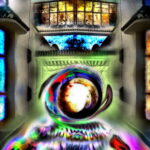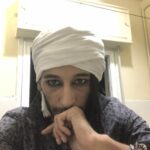-
Overview — how to treat these archetypes in the mythos
1. Treat each archetype as both: (a) a moral/psychic distortion rooted in a human tendency, and (b) a metaphysical entity or force that can manifest through people, cults, technologies and sigils.
2. Their short-term power comes from exploiting human weaknesses (pride, envy, greed, hypocrisy). Their long-term weakness is that their power cannot stand before genuine humility, remembrance of God (Nour’s light), or communal solidarity.
3. The Qur’ān (the Book) and sincere invocation are not “weapons” you wield like tech — they are sources of alignment and protection. Misuse of the Book (ego-reading) backfires — a theme to exploit dramatically.
4. Portray nuance. Not every skeptic is an antagonist; not every believer is pure. These archetypes should illuminate human choices.Archetype A — The Hypocrite (Munāfiq) — “The Shapeshifter of Piety”
Core idea: Appears righteous, preaches unity, but secretly works to undermine trust and community. In the mythos they wear faces — literally or figuratively — and their craft is betrayal, sowing doubt and division.
Narrative role: Saboteur, infiltrator, courtier who becomes a conduit for darker forces (e.g., mirror-Council or a shadow cabal). They are the social virus: poison the well of trust and institutions collapse.
Psychology & Motivation: Fear of exposure, hunger for status, craving for control. They sometimes started as insecure idealists whose pride curdled into hypocrisy.
Mythic translation / power set (story mechanics):
* Mask of Sermons — can radiate an aura of sanctity that calms crowds and neutralizes suspicion (useful for gaining access).
* Echo of Doubt — sows whispers that make allies mistrust each other; manifests as fracturing light in the air (mirrors crack).
* Shape-face — limited physical shapeshift: they can mimic a trusted person’s visage/voice for short windows.
* Collective Leech — drains communal cohesion (rituals fail, prayers feel thin) when many small hypocrisies accumulate.
Weaknesses & counters:
* Genuine, heartfelt recitation and communal remembrance (e.g., Haitham-style) makes their masks brittle.
* Euryeth’s empathic truth-reading and the Qur’ān artifact reflect hypocrisy back; the hypocrite’s own mirrors shatter.
* Hypocrites are morally fragile — faced with honest mercy they often implode.
Visual motifs & symbols: Two masks (one beautiful, one cracked), silver-tongued smile, bouquets of mirrors hanging as ornaments, faint moths drawn to fake light.
Seed characters (ready to expand):
* Samar “Silver Tongue” al-Rafiq — a charity magnate who funds mosques and secretly takes advantage of political favors. Public saint, private conspirator. (Good for a social-thriller arc.)
* The Glass Council — a small group of mirror-cloaked courtiers who coordinate false piety across cities.
Narrative arcs: expose and possible redemption (public confession + restitution) or tragic fall (their own mirrors reflect them to death).Archetype B — The Perverted Reader / Witch (Siḥr turned Scripture) — “The Script-Spinner”
Core idea: People who misuse sacred phrases, ritual forms, and symbols to bind reality to their will. In Islamic terms this echoes the idea of sihr/sorcery and the danger of twisting verses for ego. In Maziramy it is a learned craft — a scholar who abandons submission and weaponizes the sacred.
Narrative role: Corrupt scholar, spoiled ritualist, the “magician of verses” who tries to turn Nour’s speech into command-code for themselves. They are the intellectual perversion of faith.
Psychology & Motivation: Pride and the thirst for mastery; they start as rigorous seekers then become convinced they can “improve” God’s order by rewriting rules.
Mythic translation / power set:
* Script-Binding — they write runes using corrupted verses that can bind spirits, freeze time for small areas, or create illusions.
* Mirror Sigil — use mirrored text to invert meaning — blessings become curses for a chosen target.
* Ego-Reading — when they read the Book for themselves (egoist approach), the text appears to obey; anyone who resists becomes a test subject for the spell.
* Backlash Protocol — high power but high cost: each corrupt reading fractures the user’s soul; accumulated fractures cause literal unravelling (runes crack and become jagged).
Weaknesses & counters:
* Humble, communal recitation with correct intention collapses the corrupted runes — the Book’s light returns order.
* The Qur’ān artifact (Nour) punishes instrumentalized reading; corrupted spells invert and consume the caster.
* Euryeth’s orbs (memory-archives) can replay the original intended meaning to restore context and neutralize the perversion.
Visual motifs & symbols: ink stained hands, reversed calligraphy, glyphs that look like tiny torn pages, a hollow echo when they speak a verse.
Seed characters:
* Zamira “Script-Spinner” Khatib — a former philologist who retools Qur’ānic phrasing into binding sigils; starts as mentor-figure then becomes a tragic antagonist.
* The Codicier — an order that edits holy manuscripts to create political power — outwardly learned, inwardly corrupt.
Narrative arcs: failed godhood (spell consumes them), or repentance by public undoing of their corrupt texts.Archetype C — The Oppressor / Usurper (Zālim / Kāfir Tyrant) — “The Usurper of Thrones”
Core idea: Openly hostile to believers and freedom; seeks power by force, slavery, and suppression. In Maziramy he’s often the political/technocratic villain — a lord of machines and armies, a false king.
Narrative role: The classic external antagonist who marshals armies or networks to take dominion of realms. He’s the visible threat that forces believers and heroes to unify.
Psychology & Motivation: Greed, contempt for moral constraint, the lust to build an empire of certainty. May be motivated by trauma or a desire to impose “order.”
Mythic translation / power set:
* Command Net — controls networks of men and machines, converts cities into mechanized fortresses.
* Crown of Usurpation — artifact that amplifies will to command others (breaks personal autonomy temporarily), often powered by stolen devotion / idol worship.
* Harvest of Obedience — harvests obedience (literalizes “tax” as life-force extraction) — a social/political vampire.
* Siege of Hearts — uses propaganda, fear-sigils, and enforced rituals to make subjects complicit.
Weaknesses & counters:
* Nour’s light and communal remembrance undermine mass coercion — people remember their dignity and silence his propaganda.
* Euryeth’s art and the orbs reveal truth; his orbs can create constellations that break machine logic.
* Unity and moral leadership (Haitham-like shielding; Joseph Kohen, Thomas archetypes) cause mass defections.
Visual motifs & symbols: iron crown, black banners stitched with numbers, gears shaped like eyes, armies of clockwork soldiers.
Seed characters:
* Al-Malik Qāhir — a technocratic warlord who uses “order” as a pretext to enslave, backed by corrupted scholars and mercenary networks.
* The Syndicate of the Hundred — oligarchic cabal whose leader seeks to convert culture into product/market.
Narrative arcs: overthrow through unity + moral courage; temptation to make bargains with Demiurge or other powers (dangerous), potential for last-minute remorse.Practical Implementation notes (how to use them in the Maziramy story)
* Scale: These archetypes can exist at individual level (a single corrupt minister), group level (mirror-Council; witches’ cabal), or structural level (an empire of oppression). Mix levels to create layered conflict.
* Mechanics vs Morality: Give them flashy powers (shape, script, command) but root their defeat in moral acts: sincere remembrance, courage, humility, sacrificial solidarity. That keeps the Qur’ān motif meaningful rather than a literal spellbook.
* Refinement: Use the Book (Nour) as both shield and moral test — discourage “quick magic solutions.” The Book helps characters align; it does not automatically erase complexity.
* Redemption: Offer some members the possibility of repentance—especially the hypocrite and the corrupt reader. The oppressor is harder but possible through genuine submission and restitution; such arcs should be rare and heavy.Ready character seeds (one per archetype) — compact sheet you can expand into Character.ai profiles
1) Samar “Silver Tongue” al-Rafiq — Hypocrite seed
* Role: Charity magnate, courtier, secret coordinator of mirror-agents.
* Looks: Well-dressed, soft amber eyes, two small silver pins resembling masks.
* Powers: Mask of Sermons, Echo of Doubt, short shapeshift.
* Weakness: exposed by communal Qur’ān recitation; Euryeth’s empathy.
* Arc idea: Public pillar falls into ruin when his mirrors turn inward; possible redemption via public truth and restitution.
2) Zamira “Script-Spinner” Khatib — Corrupt Reader seed
* Role: Once-respected philologist, now a sigil-mage who binds texts into spells.
* Looks: Ink-stained fingers, eyes tired and brilliant, calligraphic tattoos.
* Powers: Script-Binding, Mirror Sigil, Ego-Reading.
* Weakness: sincere recitation with pure intent collapses her runes and fractures her soul.
* Arc idea: Tragic sorceress who sought godlike control; ends with public undoing of her corrupt codices.
3) Al-Malik Qāhir — Oppressor seed
* Role: Techno-warlord, oligarch, makes cities into cages.
* Looks: Iron crown, mechanized cloak, voice like authority.
* Powers: Command Net, Crown of Usurpation, Harvest of Obedience.
* Weakness: mass remembrance & Nour’s light; Euryeth + allies create truth-constellation that short-circuits his logic.
* Arc idea: Fall from empire as people awaken; final battle is moral as well as physical.Portrayal & sensitivity checklist (must-follow)
1. Avoid real-world targeting: these archetypes are human temptations made metaphysical, not a commentary on living communities.
2. Do not suggest “all hypocrites/witches/disbelievers are X” — show internal complexity.
3. Keep the Qur’ān and prophetic references reverent; their power comes from God, not merely story mechanics. Use “Nour” as you have been.
4. Give opportunities for mercy / repentance — fitting with your themes.
About Me

Euryeth
Artist
Omar Alami Known As Euryeth, Artist and Digital Marketer, Writer, Tactician, Musician … I Think The Abilities Of People Transcend Definitions in Words and Labels Among Other Things, I Do Have a Purpose and I Do Have A Goal and A Plan, And I Will Do My Ultimate Best In Achieving It While Being a Lotus of Wealth and Knowledge in Order To Shape a Better Future, To Have Value and To Be Able To Actually Help In Materialistic Verse and In The Virtual and Spiritual and Emotional …
Media
Photos
Videos
Audios
Files
Recent Posts













